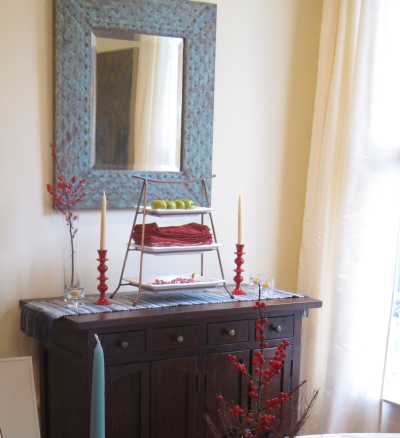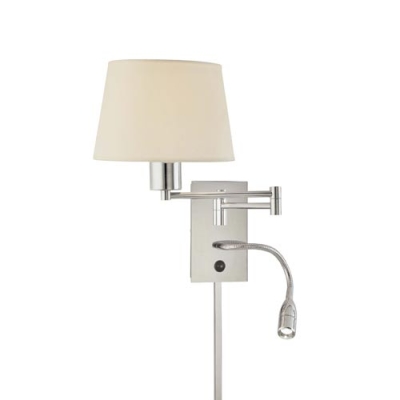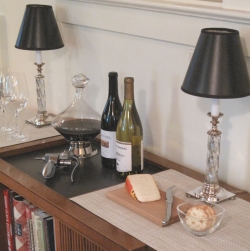 Everyone’s had the negative experience of a badly lit space: an office filled with buzzing fluorescents, or the restaurant table that seems more like an inquisitor’s seat with a blinding bulb overhead. (I have been known to grab a cocktail napkin and unscrew those offending bulbs.) I believe lighting is absolutely THE most important thing that must be right for a room to be functional and comfortable. And fortunately, better lighting doesn’t have to mean hiring a contractor or electrician. Here are five easy ways to improve the lighting in your home today:
Everyone’s had the negative experience of a badly lit space: an office filled with buzzing fluorescents, or the restaurant table that seems more like an inquisitor’s seat with a blinding bulb overhead. (I have been known to grab a cocktail napkin and unscrew those offending bulbs.) I believe lighting is absolutely THE most important thing that must be right for a room to be functional and comfortable. And fortunately, better lighting doesn’t have to mean hiring a contractor or electrician. Here are five easy ways to improve the lighting in your home today:
1. Employ the 4 layers of lighting
Beginning with the basics, it’s important to point out that there are four essential “layers”, or types, of lighting. (1) Ambient lighting is the general illumination that is provided by the combination of natural and artificial light sources. (2) Task lighting is focused on specific areas of activity such as reading or food prep. (3) Accent lighting is used to highlight art, collections, or special features in a space. (4) Decorative light sources are sometimes design objects in and of themselves, and bring intimacy and drama to a space. Here are examples of the four types of lighting that I found around my own home:
Spaces that work best usually make use of multiple layers of light. At the minimum, a room must have adequate ambient and task lighting (so a minimum of two light sources) to function effectively. To appear pleasing to the eye, a room should have light sources at different heights; for example a ceiling fixture can be supplemented by table or floor lamps. So begin by taking a critical look at the lighting in your space, and determine where additional light sources may be needed.
2. Make the most of natural light
Adding more windows and skylights is usually not an option, so how do you enhance the quality of natural light in your space? It almost goes without saying, but light paint colors reflect light, while dark colors absorb it. So use light colors in a room where you want to maximize natural light. Also, employ flexible window coverings that can be opened, closed, and adjusted as needed to control light filtration. I love to use a sheer drape or light-colored shade behind a more opaque window covering for optimum flexibility. If privacy and glare are not issues, you can even choose to forgo window coverings altogether. A third way to bounce more natural light around a room is through strategic use of mirrors. Place a mirror perpendicular to, or directly across from, a window to reflect more sunlight into the space.

Here I’ve employed all three strategies at once: light colored walls, semi-sheer drapes, and a mirror placed perpendicular to the window help to flood the room with natural light.
3. Understand what color temperature can do for you
When choosing a light bulb, a key thing to consider is the bulb’s color temperature. Measured in Kelvin (K), color temperature is a description of the warmth or coolness of a light source. 6500K is full spectrum light most closely resembling daylight, 4000-5000 K is cool light like the kind from a standard fluorescent, and 2700-3500K is a warm light like the kind cast by a traditional incandescent bulb. Full-spectrum or cooler light temperatures create stronger contrast and are better for areas requiring highly visual tasks, such as a kitchen or office. Warm light is preferred for living spaces, bedrooms, and dining rooms because it’s more flattering to skin tones. The good news is that even energy-saving compact fluorescent and LED bulbs are now available in a range of color temperatures, including ones in the warm spectrum.

Compact fluorescent bulbs have come a long way from those old spirally ones. Here’s a warm white option from DestinationLighting.com.
Also be aware that a bulb’s color temperature will affect the appearance of color in a room. Colors appear truest under daylight or full spectrum light. A warm white bulb will make warm colors (red, orange, yellow, brown) appear richest, whereas a cool bulb will make warm colors appear more muddy. So next time you go shopping for lightbulbs, look for the K measurement on the package and make your selection based on the room where it will be used.
4. Select fixtures that cast indirect or shaded light
The harsh glare of an overhead lightbulb is really not flattering on anyone. Whenever possible, choose fixtures that are shaded, or that cast light UP or against a wall surface. I love to use sconces for ambient lighting in a room for this very reason: they wash the wall surface with light and bounce it off the ceiling, creating soft and pleasant general illumination. If changing the fixture isn’t an option, choose a bulb with a frosted lens, which will also help diffuse the light.

This pin-up lamp from George Kovacs combines a reading light with a swing-arm sconce for indirect ambient light. Image via bellacor.com.
5. Install dimmers
I am a dimmer fanatic and install them everywhere with wild abandon. And why not?? They’re inexpensive, easy to install (you don’t need to be an electrician to do it) and they allow you to control the light level in a room effortlessly. Everyone should have dimmers. Enough said.

A typical dimmer switch. Be sure to buy dimmable light bulbs for use with a dimmer switch. Photo via DestinationLighting.com.
So there you have it, five (pretty) easy ways to make the light quality better in your home. I hope you’ve found it helpful!




